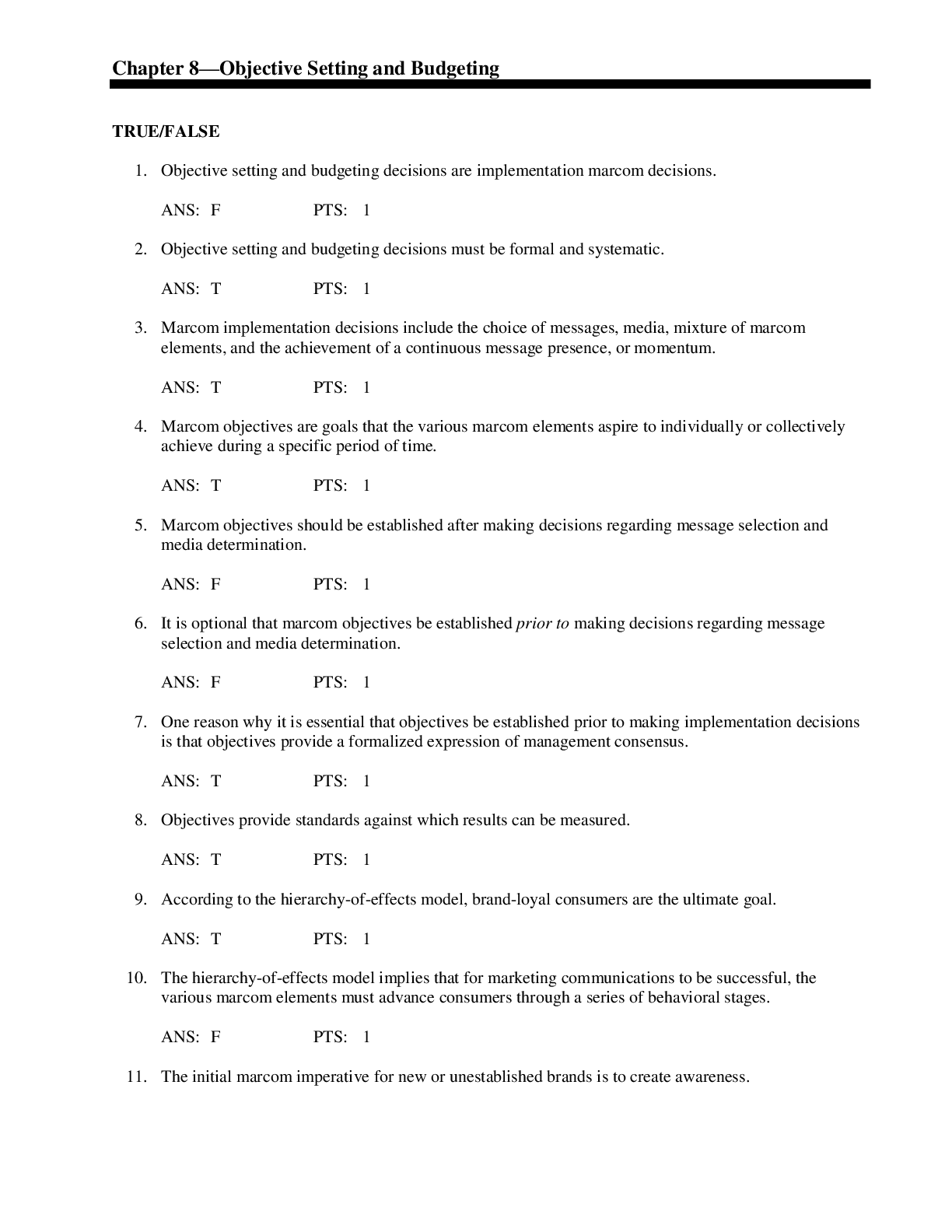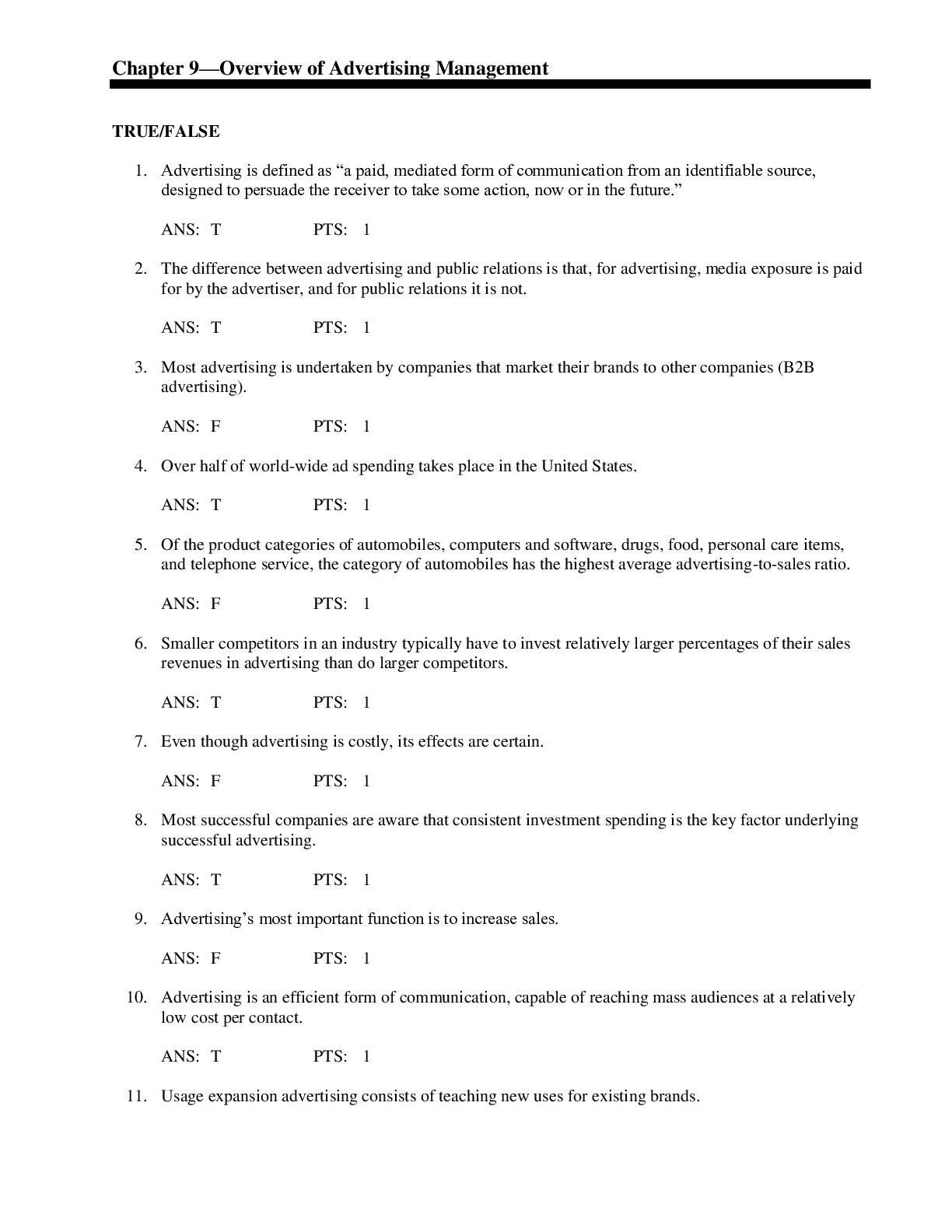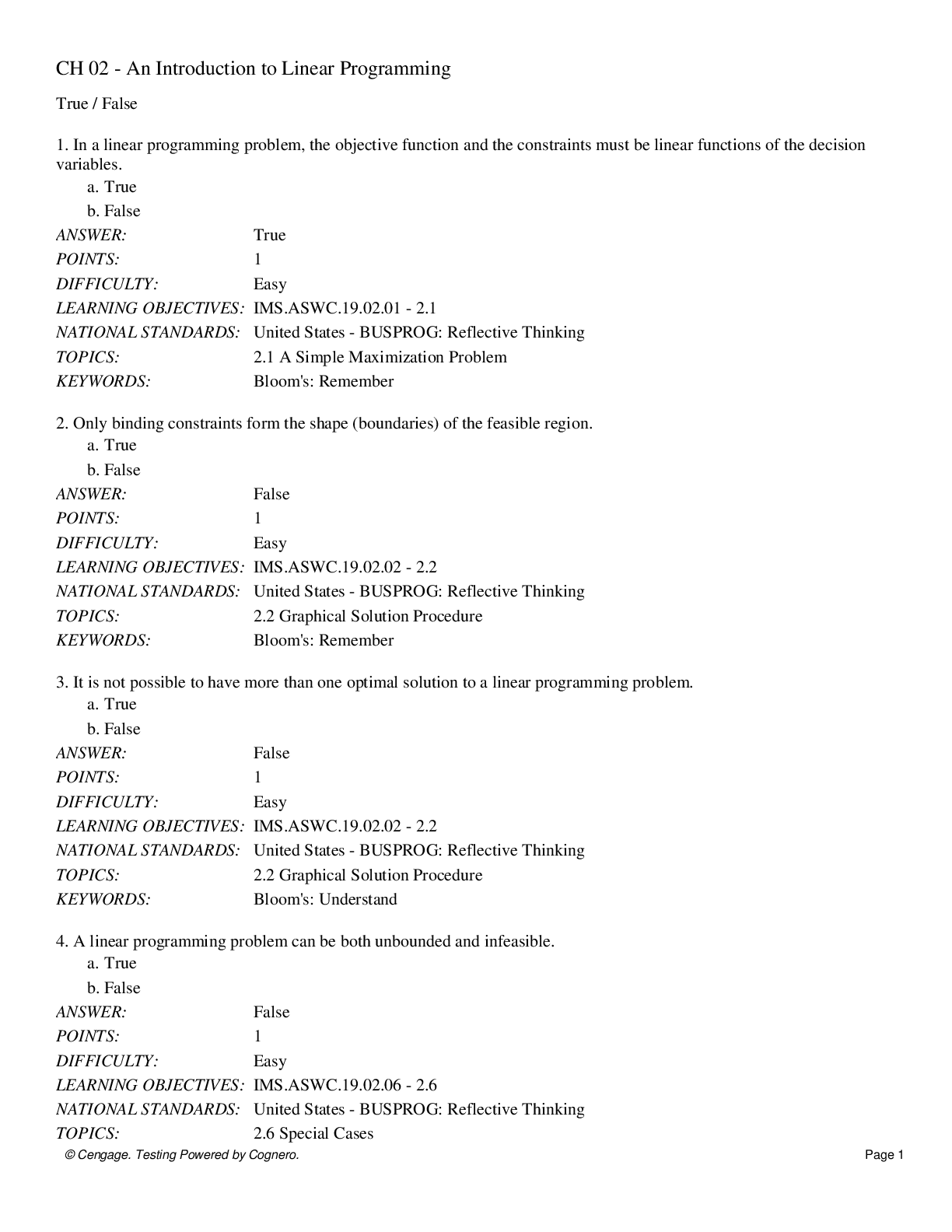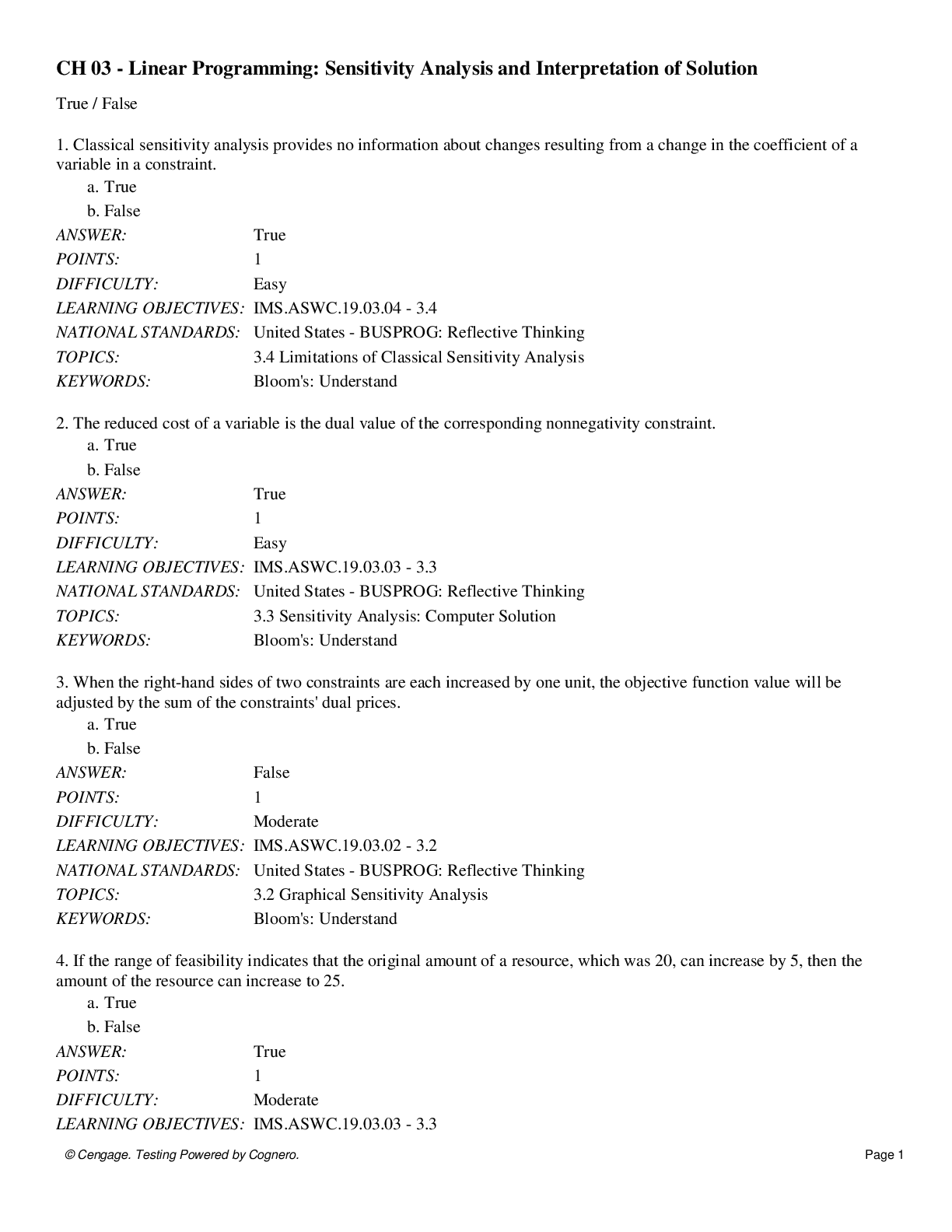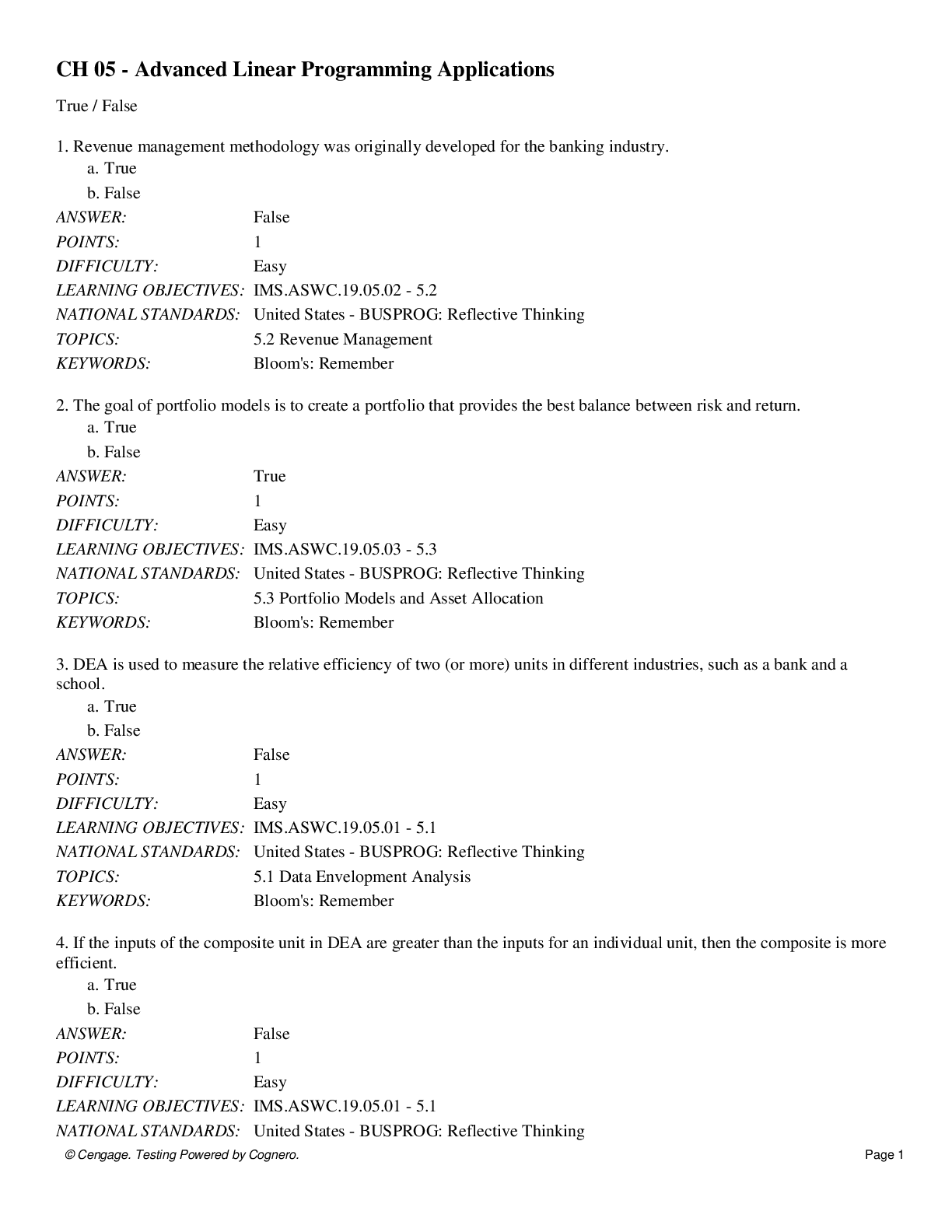Medicine > QUESTIONS & ANSWERS > AMLS Test Questions and Answers 100% Pass (All)
AMLS Test Questions and Answers 100% Pass
Document Content and Description Below
AMLS Test Questions and Answers 100% Pass What condition is most likely to cause respiratory acidosis? ✔✔In larger doses narcotics induce respiratory depression and eventually respiratory arres... t. AMLS Page 95 A 65-year-old female complains of chest pain that feels like "aching" in her chest. It has become progressively worse over several days. Her temperature is 38.3 degrees C (100 F). Which finding will help narrow your differential diagnosis to pericarditis? ✔✔12 lead ECG will demonstrate global ST-segment elevation in almost every lead. AMLS Page 128 During compensatory shock, the renin-angiotensin-aldosterone system is activated to cause a/an: ✔✔This selective perfusion occurs during the ischemic phase of shock. AMLS Page 146 (To stop kidneys from excreting fluid and keeping it in the vasculature, therefore increasing BP) lntrabdominal bleeds, like pancreatitis, often present with discoloration or bruising around the umbilicus. This physical exam finding is known as: ✔✔Cullen's sign is a blue discoloration around the umbilicus. AMLS Page 235 What clinical findings are most commonly associated with a pulmonary embolus? ✔✔Clear breath sounds with tachypnea. Signs and Symptoms AMLS Page 113 A 50 year old female has called 911. She complains of shortness of breath and chest. discomfort. Assessment reveals her skin is pale, moist and cool. BP is 102/68, R 24, labored with crackles, P of 130 and regular. Which type of shock is most likely occurring? ✔✔The patient's respiratory rate is increased, and crackles caused by pulmonary edema can be heard on auscultation. Cardiogenic Shock Signs and Symptoms. AMLS Page 164 Patients with a history of COPD that present with an acute onset of shortness of breath are likely to have which condition? ✔✔Elements of patient history that suggest PE include acute onset of shortness of breath. AMLS Page 114 An elderly patient with a 1 week history of productive cough and wheezing notices an increase in difficulty in breathing when grocery shopping. Further assessment reveals pursed lip breathing, rhonchi, and minimal jugular vein distention. Which diagnosis should the healthcare provider suspect? ✔✔Signs and Symptoms of COPD. AMLS Page 85 A 45 year old patient is found supine on the floor. Healthcare providers note pinpoint pupils, shallow respirations and vomitus in and around the mouth. What course of action should be implemented next? ✔✔This is self explanatory (Suction Airway) A 20 year old female presents with a 2-day history of dyspnea, non-productive cough, chest tightness audible wheezing. Further exam reveals no fever or strider. The patient has rapid respirations with difficulty exhaling. Which diagnosis is most likely? ✔✔These are textbook signs of asthma Signs and Symptoms.AMLS Page 83 Anaphylaxis is most associated with which physiological event? ✔✔The cutaneous reaction may be observed as flushed, warm skin resulting from vasodilation and uticarea. AMLS Page 162 An elderly patient is receiving care at home while recuperating from recent knee surgery. She developed post a operative infection and has been on antibiotics for quite sometime. She is complaining of foul smelling diarrhea, and abdominal cramping and loss of appetite. Based on this presentation, the provider should suspect? ✔✔Signs and Symptoms Patients with this illness have diarrhea that is not bloody but has a characteristic foul odor. Abdominal pain and cramping are present in about 22% of patients. AMLS Page 319 (C-DIFF) Acute Respiratory Distress Syndrome (ARDS) is characterized by what pathological change? ✔✔Pathophysiology AMLS Page 88 (Caused by diffuse damage to the alveoli, perhaps as a result of shock, aspiration of gastric contents, pulmonary edema or hypoxic event. Begins with a breakdown of the alveolar-capillary border that allows fluid to seep into the alveoli, decreasing gas exchange in the lungs. Healthcare providers are responding to a near-drowning at a local lake. The patient is experiencing uncontrollable shivering and complains of nausea and weakness. The patient had been treading water for 25 minutes and now presents with tachycardia and rapid respirations. Core body temperature is 93.2°F (34°C). Which diagnosis is most likely? ✔✔89.6F - 95.0F (Mild Hypothermia) AMLS Page 338 Continuous positive airway pressure would be most appropriate in treating which patient? ✔✔22 year old with severe asthma and not responding to nebulizer treatments AMLS Page 72 A local businesswoman has returned from missionary work in South Africa. She is complaining of night sweats,chest discomfort and a persistent cough for several weeks. Which underlying diagnosis is most likely causing these symptoms? ✔✔Signs and symptoms of TB include persistent cough for 2-3 weeks, night sweats, headache, weight loss, hemoptysis, and chest pain. AMLS Page 301 What is the initial treatment for a patient experiencing Hyperosmolar Hyperglycemic Nonketotic Syndrome (HHNS)? ✔✔The patient may have significant volume depletion. Begin IV fluid resuscitation immediately. The initial fluid of choice is 0.9% normal saline (crystalloid solution). AMLS Page 270 When assessing geriatric patients, infectious disease is more difficult to identify for all the following reasons EXCEPT ✔✔Older Adult Patients. AMLS Page 325 Your patient has had a seizure secondary to a nerve agent exposure. What medication would be best to diminish the seizure? ✔✔If seizures develop administer diazepam (Valium) or lorazepam (Ativan). AMLS Page 424 (Treat seizure before treating for the exposure to the nerve agent) A caregiver for a quadriplegic patient notes an onset of difficulty in breathing and anxiousness in her patient. Further assessment shows a temperature of 101.2°F (38"C), P 128, BP 86/68, and R 24. Physical exam shows the skin is warm and urine in the Foley catheter is dark yellow and cloudy. This patient is most likely experiencing what type of shock? ✔✔AMLS Page 159, Table 4-11 (Septic Shock) Respiratory Alkalosis may occur as a result of? ✔✔Some causes of primary respiratory alkalosis include aspirin overdose, anxiety reaction, and pulmonary embolism. See table AMLS Page 272. A 22-year old male has recently undergone a surgical procedure to repair an injury to the thoracic vertebrae T4-T6. Assessment indicates the patient is alert and oriented, bradycardic, hypotensive and has warm dry skin which type of shock is most likely occurring? ✔✔In neurogenic shock the patient is often both bradycardic and hypotensive. AMLS Page 149. Warm, dry, pink skin, decreased BP, alert, normal capillary refill. AMLS Page 157 table 4-9 An age related change that increases the risk of respiratory compromise is ✔✔Reduced lung compliance due to calcification of cartilage in the trachea and bronchioles and calcification of interstitial tissue. AMLS P. 98 A patient complaining of a 3-day history of left, lower abdominal pain describes it as sharp in nature and, during the focused physical exam, the pain intensifies during palpation over the site. Differentials should include ✔✔Ectopic pregnancy or diverticulitis (Question does not state the PT is female, but pick ectopic pregnancy) Paroxysmal Nocturnal Dyspnea is most common in patients with a history of? ✔✔AMLS Page 60 Table 2-1 (Left-sided heart failure) The most common underlying medical conditions found in patients with acute pancreatitis is ✔✔The disease is thought to be caused by cholelithiasis (gall stones) or alcohol abuse in more than 90% of cases. AMLS Page 235 The patient presents with a history of fever and an upper respiratory infection. Historical Information reveals increasing water intake, orthostatic hypotension and an Increase in urination. You suspect these symptoms are caused by? ✔✔This is hyperglycemic DKA. Patients with DKA are dehydrated and appear ill. They usually report polydipsia (great thirst), polyphagia (excessive hunger), and polyuria (excessive urination). Patients with severe cases will exhibit altered mental status, tachycardia, rapid breathing and orthostatic changes. AMLSPage 268 The healthcare provider is assessing a 60 year-old female patient with complaints of indigestion and mild upper abdominal discomfort. This presentation should prompt the provider to: ✔✔Indigestion and mild upper abdominal pain discomfort should prompt you to evaluate the patient for acute coronary syndrome. AMLS Page 225 You are dispatched to the home of a 32 year old patient with a history of Graves disease. The patient was in the ER earlier today for some "tests for my ulcers". He received contrast and was discharged. He is now complaining of not feeling well, chest pain and palpitations. You note an anxious patient with fine tremors. He is diaphoretic and has a fever if 101.5. BP 100/62, P156, R 30, Glucose 133. Which of the following are management considerations for this patient? ✔✔This is a thyroid storm. The goals of pharmalogic treatment in the prehospital setting are to block the peripheral adrenergic hyperactivity the thyroid hormones elicit (tachycardia, fever, anxiety, and tremors). This can be achieved by administering beta blockers. The drug of choice is propranolol. Treatment AMLS Page 261 A patient presents anxious with difficulty in breathing and chest pain. An assessment reveals hypotension, muffled heart tones and distended neck veins. There is a past medical history of pericarditis. The provider notes that there is decrease in systolic blood pressure when the patient inhales. Which diagnosis would be considered with this presentation? ✔✔The signs and symptoms are usually described in a triad including hypotension (low CO), distended neck veins (high right sided heart pressures), and muffled heart tones (fluid outside the heart) Signs and Symptom AMLS Page 119 (Pericardial Tamponade) Metabolic acidosis is best described by which arterial blood gas interpretation? ✔✔Metabolic acidosis is caused by a deficiency of bicarbonate ion (base) and and excess of hydrogen ion (acid). In the acute stage the body's physiologic response is to hyperventilate and compensate by reducing PaCo2. AMLS Page 273 If untreated, a cardiac tamponade will present with signs and symptoms of which type of shock? ✔✔Cardiac tamponade occurs when fluid accumulates inside the layered pericardial sac surrounding the heart itself. This causes compression forces around the heart, restricting its movement and causes subsequent OBSTRUCTIVE SHOCK. AMLS Page 119 The AMLS Assessment Pathway first advises safety and initial observations of the scene. The second process described in this pathway asks the healthcare provider to ✔✔Part of the Primary Survey. Identify life threatening presentations and establish immediate management strategies. AMLS Page 9 A daughter states that her 72 year old mother has a history of hypertension, high cholesterol and rheumatoid arthritis. Daily medications include: aspirin (NSAID), tenormin (beta-blocker), plaquenil (anti-malaria) and plavix (Anti-platelet). She is concerned as her mother has mixed up her medications and is now lethargic with diminished respirations. Vitals signs are P 58 and regular R 10 and shallow BP of 90/70. Blood Glucose level is 52 mg/dl (2.8mmol/L. Which medication toxicity would be indicative of this presentation? ✔✔Beta-blocker toxicity as been associated with respiratory depression, bradycardia, hypotension and mental status depression. Page 360. Patients usually present with bradycardia and hypotension. Page 372. Altered mental status may be caused by cerebral hyperprofusion or the direct CNS depressive effects of the drug. AMLS Page 372 Observing a patients body positioning can be an early indicator that the patient is ✔✔First impressions: Extrinsic clues can include body positioning, expressions of pain, and abnormal breath sounds. AMLS Page 15 Which of the following is a hallmark sign of tricyclic antidepressant toxicity? ✔✔Late signs and symptoms include respiratory depression, confusion, hallucinations, hyperthermia, ventricular dysrhythmias, (such as torsades de pointes and wide QRS complexes), and seizures. AMLS Page 375 Which assessment finding is crucial to obtain from a patient suspected of a stroke? ✔✔A very important point to differentiate here is the time the patient was last seen acting normally and the time the symptoms are discovered. AMLS Page 185 The provider assesses a patient suffering from fever, nausea, vomiting and peri-umbilical pain. Further evaluation reveals right lower quadrant and lower back pain. A physical exam reveals an increase in right lower quadrant pain when the patient's right leg is extended from the hip. Which working diagnosis is most appropriate? ✔✔Psoas sign (Place PT in left lateral decubitus position and extend the right leg at the hip. Exacerbation of pain in the right lower quadrant is a positive psoas sign) AMLS Page 236 Peri-umbilical pain tends to be related to the appendix, small bowel, or cecum. AMLS Page 217 A 62 year old patient presents with a severe headache. It is described as a "thunderclap" accompanied by nausea, blurred vision and an elevated blood pressure. What neurological condition is most likely causing this patient's presentation? ✔✔Subarachnoid hemorrhage should be suspected in any patient who describes a sudden, severe headache that came on like a "thunderclap". AMLS Page 190 A patient complains of nausea and is passing black, tarry stools rectally. This patient is most likely suffering from ✔✔Dark or black blood in the stool may indicate either old bleeding or the digestion of blood from an upper GI-bleed. AMLS Page 149 A 38 year old presents with mild chest tightness and urticaria after mowing the lawn. He felt a "sting" in his left lower leg and states the symptoms came on suddenly. BP 130/82, pulse 100, respiratory rate is 20 with a normal work of breathing. The healthcare provider should ✔✔Initiate an IV with 0.9% Normal Saline and monitor the patient carefully (If there is no work of breathing, delay administering epi. Try to manage PT w/ least amount of interventions as possible) Healthcare providers are treating a patient that has taken an unknown amount of a prescribed pain medicine, along with an over-the-counter analgesic numerous times over the past 36 hours for chronic lumbar pain. The patient is experiencing abdominal pain, nausea and vomiting. The providers note pallor and diaphoresis blood sugar is 42 mg/dl (2.3 mmol/L). What toxin overdose is suspected? ✔✔Stage I/II APAP (Acetaminophen) toxicity signs and symptoms are characterized by abdominal pain and worsening nausea and vomiting. AMLS Page 363 Healthcare providers are treating a patient complaining of substernal chest pain accompanied with nausea and 1 episode of vomiting. The patient has had 2 cardiac stents placed within the last year. He has a familial history of heart disease and takes a baby aspirin daily. What information is most concerning? ✔✔If the patient has having chest pain and had a stent recently placed, for example, that information is pertinent. AMLS Page 20 A firefighter has been working a fire for 4 hours on a humid, hot day. He suddenly becomes nauseated and restless. The provider observes pupil dilation and an almond odor to his breath. The vital signs are P 56, RR 22, BP 140/86. The ECG reveals sinus bradycardia with occasional PAC's. Which toxin exposure has occurred? ✔✔One of the most common asphyxiants is hydrogen cyanide. Notable for its bitter almond-like odor found in a solid form. Page 422. Clinical presentation includes bitter almond odor to breath. AMLS Page 366 The patient complains of sharp chest pain that worsens when supine. He is bed ridden due to complications from a recent hip surgery. The patient is tachypneic and the ECG reveals sinus tachycardia. What is the patient's working diagnosis? ✔✔Patients at risk of pulmonary embolism include those who have recently had surgery. The classic triad of chest pain, hemoptysis, and dyspnea is seen in fewer than 200/o of patients. Early symptoms of pulmonary embolism may be minimal, but massive pulmonary embolism evolves quickly and may rapidly become symptomatic, leading to cardiac arrest with pulseless electrical activity as the presenting rhythm. AMLS Page 92 Healthcare providers are assessing an obese 49 year old who is lethargic and not feeling well for several days. His family reports a history of extreme thirst. Vital signs are P 143, R 14, and BP 88/58. He takes medication for type 2 diabetes daily. What is the most probable working diagnosis? ✔✔Signs and symptoms of HHNC include fever, dehydration, vomiting, and abdominal pain, hypotension, tachycardia, rapid breathing, thirst, polyuria, or oliguria, polydipsia, focal seizures, altered LOC, focal neurological deficits. AMLS Page 270 A patient is a resident in an assisted living facility to obtain physical therapy after a knee replacement surgery. She complains of a skin rash that is red and has small bumps. She has been feeling ill for several days. What is most likely the working diagnosis? ✔✔A patient with MRSA may have fever, redness, localized pain, small red bumps, or deep abscesses that can affect bones, joints, heart valves, and the blood stream. AMLS Page 318 While assessing your patient, you note he involuntarily flexes the legs in response to flexing the neck. The patient is presenting with ✔✔Involuntarily flexing of the legs in response to flexing of the neck is a positive Brudzinski's sign. AMLS Page 196 A foreign exchange university student is found by his roommate and EMS is dispatched. The patient presents with an unusual flat red rash on his chest and arms. He has been ill with fever, nausea, and vomiting. Physical exam reveals nuchal rigidity. The healthcare provider will anticipate which diagnosis? ✔✔Patients with acute bacterial meningitis may decompensate quickly and require emergency care and antibiotics. The classic symptoms of meningitis include headache, nuchal rigidity (resistance to flexing/extending the neck), fever and chills and photophobia. The infection can also cause seizures, altered mental status, confusion, coma, and death. The condition is usually precipitated by an upper respiratory infection. AMLS Page 195 Healthcare providers are managing a 49 year old male complaining of diffuse abdominal cramping. He has been ill with vomiting for 3 days. What working diagnosis is most probable? ✔✔Patients will present gastrointestinal complaints including abdomen pain, vomiting, projectile vomiting, diarrhea, and fever. Symptoms last 1-2 days and then patients make a full recovery. AMLS Page 307 (Norovirus) [Show More]
Last updated: 1 year ago
Preview 1 out of 15 pages
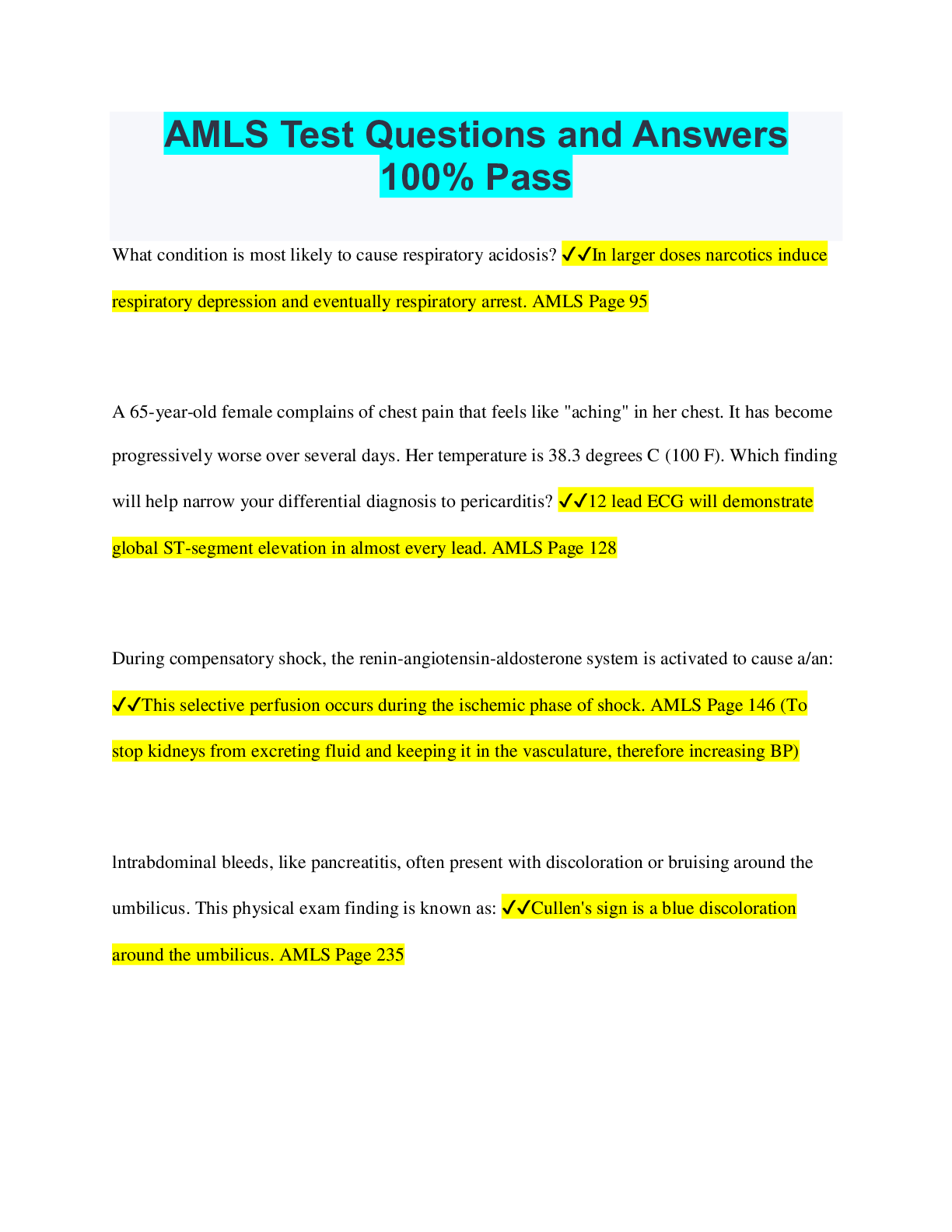
Buy this document to get the full access instantly
Instant Download Access after purchase
Add to cartInstant download
We Accept:

Also available in bundle (1)

AMLS BUNDLED EXAMS QUESTIONS AND ANSWERS WITH VERIFIED SOLUTIONS
AMLS BUNDLED EXAMS QUESTIONS AND ANSWERS WITH VERIFIED SOLUTIONS
By Nutmegs 1 year ago
$20
9
Reviews( 0 )
$10.00
Document information
Connected school, study & course
About the document
Uploaded On
Apr 18, 2023
Number of pages
15
Written in
Additional information
This document has been written for:
Uploaded
Apr 18, 2023
Downloads
0
Views
90

.png)
.png)
.png)
.png)
.png)
.png)
.png)
.png)
.png)
.png)
.png)





